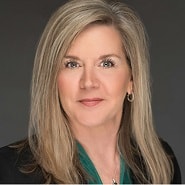
Sarah Richardson, CIO, Calif. Market, Healthcare Partners

Tressa Springmann, VP & CIO, LifeBridge Health

Julie Bonello, CIO, Rush Health
Women and men are inherently different.
Men are better negotiators, more confident, and more likely to take risks. Women, on the other hand, are better team players and are more mission-driven.
We’ve heard these sentiments so many times — and for so long — that they’ve become widely accepted as facts. The reality, according to a Harvard Business Review, is that there are differences between men and women. “But they’re not rooted in fixed gender traits,” it states. “Rather, they stem from organizational structures, company practices, and patterns of interaction that position men and women differently, creating systematically different experiences for them.”
In other words, the reason women occupy fewer leadership roles in fields like healthcare IT is more about nurture, and less about nature. It can be a very discouraging thing to hear. But it also can be inspiring, according to Women in Health IT Leadership panelists, who believe it’s time to move past the (justified) anger many women feel and work to forge change.
Recently we spoke with three influential women about the challenges they’ve faced in their careers, what they consider to be core competencies for female leaders, and why diverse representation is so critical in today’s environment. The panelists — Sarah Richardson, California Market CIO, Healthcare Partners; Julie Bonello, CIO, Rush Health; and Tressa Springmann, CIO, LifeBridge Health — also share their thoughts on how to encourage a healthy work/life balance, how to build a safe culture, why mentoring matters so much, and the discussion that needs to happen on a wider scale.
Chapter 3
- Creating a safe environment: “Make yourself available.”
- New parent groups – “It creates a really good camaraderie.”
- Safe & sick leave: “You don’t owe an explanation”
- Learning from male-dominated environments
- “I observed a lot about what behaviors I needed to exhibit.”
- Different paths to leadership roles
- “The CIO job is just one of several technology leadership positions.”
LISTEN NOW USING THE PLAYER BELOW OR CLICK HERE TO SUBSCRIBE TO OUR iTUNES PODCAST FEED
Podcast: Play in new window | Download (Duration: 10:58 — 10.0MB)
Subscribe: Apple Podcasts | Spotify | Android | Pandora | iHeartRadio | Podchaser | Podcast Index | Email | TuneIn | RSS
Bold Statements
What I’m finding is men are sometimes more tentative to have those conversations. They’re scared that they might screw up and say something that further creates this lack of parity or perception of equities. And so we have to create a safe environment.
If there are folks who are worried or reluctant or don’t feel safe — because, sadly, sometimes that happens with a leadership transition — there are actually accommodations in place so that when you need to take that time, you go ahead and take it. You don’t owe an explanation.
I look around a lot and I observed a lot. I thought about what behaviors I need to exhibit to move ahead. In an environment like consulting, you’re on different projects all the time. So it was a great learning opportunity.
I’ve noticed more and more that while it’s important for us to have that aspect of STEM within technology, what’s also important is that you have the ability to communicate and understand all aspects of operations, marketing, leadership, etc., and the acumen to understand how technology complements the business.
Gamble: Are there ways to try to help make sure an environment is safe? Open discussion, of course, is important, but any other advice?
Springmann: I think that’s where we actually have a gender advantage, because I can have a very honest discussion with the men who work for me and if they’re uncomfortable having a specific conversation, I offer my assistance. I’ll say, ‘I’m happy to sit in if you’re having a career discussion with an individual, and she you think she may not feel comfortable.’ It’s making myself available and creating accountability, because what I’m finding is men are sometimes more tentative to have those conversations. They’re scared that they might screw up and say something that further creates this lack of parity or perception of equities. And so we have to create a safe environment. And as female leaders, we actually have a little bit more influence over being able to do that.
Gamble: It’s interesting because in the last year or so, the environment has really changed, and some of these topics have become so delicate that nobody wants to touch them. That doesn’t make anything better — in fact, it can maybe even set things back.
Richardson: In my organization, lately it seems all the babies being born are on the father’s side — at least on my team — and so I encourage the guys to take leave. I’ll say, ‘how much time are you taking off? Who is handling your work while you’re gone? And they look at me like, ‘what do you mean?’ And I’ll say, ‘you’re taking time off to spend with your child.’ We need to remind them that it’s okay from a society perspective, but also that we allow the time in our company and they should take that, because it’s precious time. We got some of the guys together and told them they should start a daddy users group with some of the other parents here to help them assimilate. And so everyone who has a child under 2 will get together and do a brown bag lunch once a month so they can share ideas on how to manage a family and career. Most of them are first-time parents, and we’ve found that it’s created a really nice camaraderie. When you’re trying to manage a family and a career — and especially if you’re the breadwinner — it’s challenging. But these challenges are not unique, and so this has been really well-received by the team.
Gamble: That’s a great idea. As far as making the workplace safe, do you think your approaches have changed because of the environment we’re in?
Springmann: Recently, there have been some legal changes implemented with the safe and sick leave policy in our organization; although perhaps it was catalyzed by other reasons. Our employees have time every pay period they accrue where they can take leave that’s free from an inquiries of why it’s needed. The intent is, if there are folks who are worried or reluctant or don’t feel safety — because, sadly, sometimes that happens with a leadership transition — there are actually accommodations in place so that when you need to take that time, you go ahead and take it. You don’t owe an explanation or need to offer a doctor’s note. So we’d like to think we’re creating an environment where you don’t need such stringent backstop, but it’s also just a nice safety net.
Bonello: We’ve talked a lot about family. What it comes down to is really building broader personal relationships with everyone. From my standpoint, family is just one of those safe places where everyone can get to know each other. In our case, it hasn’t really been an objective or a goal, but it just happened that it’s the one place where we can all develop trusting relationships and know that we care about one another, and it’s something that we all care about. That’s been a big focus.
I thought of Tressa’s earlier comments about fitting into what was perhaps more of a male-dominated environment, and she made a very good point. I was in consulting for a while. This was a bit far back — it was a heavily dominated-male environment, and I thought that was really helpful for my career. I think it’s really good for women who are moving their careers forward to feel comfortable in different work environments. It’s really important.
Springmann: Women who want to grow through leadership can also potentially can make the environment safer for that. By making it safe for whomever they’re working with or reporting to, they’ve now really created a real opportunity for themselves.
Gamble: Right. Julie, you said that working with a lot of men in consulting was beneficial. In what ways do you think it helped you or change your perspective?
Bonello: I think the breakdown was maybe 50/50, but the culture and the partnership levels were more male-dominated. In terms of how it helped me, I look around a lot and I observed a lot. I thought about what behaviors I need to exhibit to move ahead. In an environment like consulting, you’re on different projects all the time. So it was a great learning opportunity for me to figure out how to work in a male-dominated teams and cultures.
Springmann: I think this is a good reminder to — and I’ll admit, I’m a bit of a Pollyanna — to look at the cup as being half-full. This is healthcare; although the leadership ranks in provider settings are still very much male-dominated, we’ve got it good compared to other industries that don’t have such a strong female presence, especially in the clinical space.
Bonello: It’s interesting. I work in population health and I work a lot with care management areas, and in talking with some women in leadership and in that area, what’s challenging is that many of them have come up through different clinical areas like nursing, and they’ve had less exposure to working in a male-dominated setting, and so it becomes more difficult to figure out how to best navigate that and feel confident.
Gamble: When you look at the CIO role, there are so many different paths that can lead to it. Do you think that, over time, it will attract a more diverse group of people than in years past, where it was largely people from technology backgrounds?
Richardson: I say yes, because I didn’t come from a STEM background. I came from operations, and I’ve noticed more and more that while it’s important for us to have that aspect of STEM within technology, what’s also important is that you have the ability to communicate and understand all aspects of operations, marketing, leadership, etc., and the acumen to understand how technology complements the business and be a true partner. That’s why we’re seeing more and more leaders come in from either the medical side or from non IT to come in and facilitate those conversations. And so I believe we’re going to continue to see leaders come in to technology roles that may have not had a historical technology background as their first foray into the industry. Industries like hospitality, healthcare, and education have very similar foundations, and it’s nice to be able to see colleagues be able to move and pivot into other areas, bringing their skills and capabilities with them to new organizations.
Bonello: And then the question is, do you absolutely want the CIO job? There are going to be a lot of C-suite jobs; we’re going to see healthcare become more disrupted in the next couple of years. Health IT is such a huge field now, with so many different avenues to make a real huge difference, and I think there will be so many new different jobs. From a mentoring standpoint, sometimes I feel like I’m just an organizational design to help figure out how to direct people; to how define a professional development path because we don’t know where everything’s going, and to help people figure out how to put the pieces together for themselves. I think this is really exciting, because the CIO job is going to be just be one of several technology leadership positions.


Share Your Thoughts
You must be logged in to post a comment.